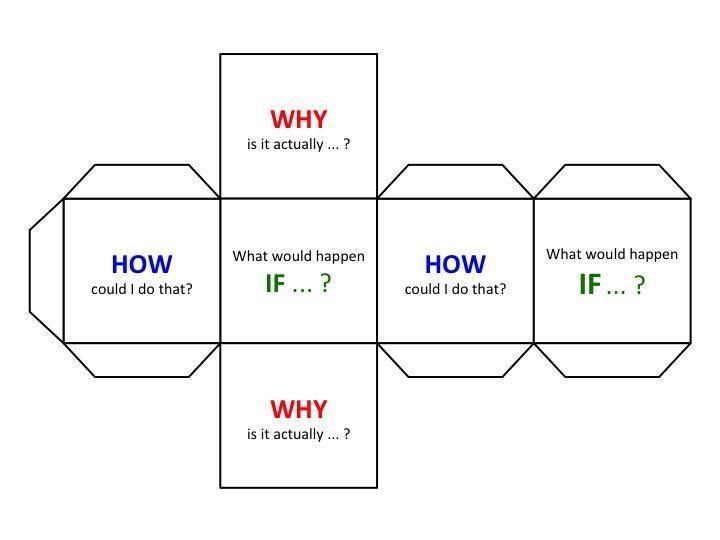The Question Game: A Playful Way To Teach Critical Thinking
What’s The Question Game? A playful way to help students learn to ask the right question at the right time–with a paper cube.

Teaching Critical Thinking With The Question Game
contributed by Sophie Wrobel, geist.avesophos.de
Big idea: Teaching kids to ask smart questions on their own
A four-year-old asks on average about 400 questions per day, and an adult hardly asks any.
Our school system is structured around rewards for regurgitating the right answer, and not asking smart questions – in fact, it discourages asking questions. With the result that as we grow older, we stop asking questions. Yet asking good questions is essential to find and develop solutions, and an important skill in innovation, strategy, and leadership. So why do we stop asking questions – and more importantly, why don’t we train each other, and our future leaders, to ask the right questions starting from early on?
In A More Beautiful Question: The Power of Inquiry to Spark Breakthrough Ideas, Warren Berger suggests that there are three main questions that help in problem-solving: Why questions, What If questions, and How questions.
Regardless of the question, the question needs to be phrased openly and positively in order to achieve positive results – a closed or negative question only raises bad feelings against each other.
Why questions help to find the root of a problem
What If questions open up the floor for creative solutions
How questions focus on developing practical solutions
So, perhaps, this lesson can be adapted to help trigger young children to start to solve problems early too and stop accepting whatever the kindergarten teacher says to be fact? And perhaps, continue to keep up these inquiring and probing abilities later on in life?
Learning Goal: A Pattern Of Critical Thinking
The Question Game focuses on teaching children a kind of thinking which is particularly useful in creative problem-solving–a focused approach to get from a problem to the most effective solution. It is most effective when combined with regular repetition, which solidifies the thought pattern, and with groups, which encourages contributory exploration of alternative responses and creativity.
Thinking strategies are just one of many strategies that are necessary for imparting charisma and leadership skills to the next generation. Many of us would claim that we don’t have the ‘natural gift’ that charismatic leaders like Nelson Mandela or Mahatma Ghandi had. However, charisma and leadership are qualities that, to a large extent, can be cultivated and trained. With soft skills becoming more important in today’s job market, cultivating these skills early on can provide children with an additional edge in becoming effective, active citizens in our society. These skills can be broadly grouped into four logical skills and four emotional skills:
Logical skills: risk-taking, thinking strategy, creativity, and negotiation.
Emotional skills: persuasion, emotional connection, body language, and dealing with vulnerability.
Of these eight skills, the Question Game focuses on thinking strategy and creativity and aims to solidify the critical thinking thought pattern from an early age onwards.
Introducing The Question Game
Preparation: print out the figure in the illustration, cut it out and glue the tabs together to form a cube.
One simple idea is to pick up your favorite illustrated fairy tale book–the kind of book you’d read a two-year-old for bedtime stories. (This also works with most fictional works; the natural ‘breakpoint‘ for questions is at the end of plot development or paragraph for older audiences.)
On each page, roll the cube and answer the question together. I’ll bet you’d be surprised by what turns Little Red Riding Hood can take. And more importantly, after a while, you and your child will both start asking these questions reflexively.
Evaluating Learning Progress In The Question Game
My personal experience introducing the game to my two children (aged Pre-K) is a gradual acceptance of the game and associated learning goals:
Initial excitement: Rolling the cube puts the child in control and made a fun addition to reading their picture books; they couldn’t wait for their turn to roll the cube.
Distress: The questions are hard, especially when they aren’t used to this sort of thinking pattern and are accustomed to the ’teacher knows everything’ thinking pattern. Here, my children often asked if we could read ‘without the cube‘, or ‘I don’t want to roll, but ___ can roll and answer the question.’
Acceptance: As they start to recognize that there isn’t a single correct answer, and they begin to understand what each question is trying to achieve, they begin to enjoy the game and insist that we read ‘with the cube‘.
Application: During more abstract conversations, discussions, or observing how the children go about solving day-to-day problems during play. Example: a particular lego construction doesn’t quite work, even though it was‚ built according to instructions‘–and the child goes about investigating what is wrong and fixing it himself. Another example: When they ask me questions and I give them answers that obviously don’t make sense, I get more pointed questions than just ‘why?’ as a response.
Sophie Wrobel is a mother of two and independent information consultant with no pedagogic background. She runs a technology-oriented blog at avesophos.de and a self-improvement blog at geist.avesophos.de; The Question Game: A Playful Way To Teach Critical Thinking; image attribution flickr user usarmycorpofengineers
